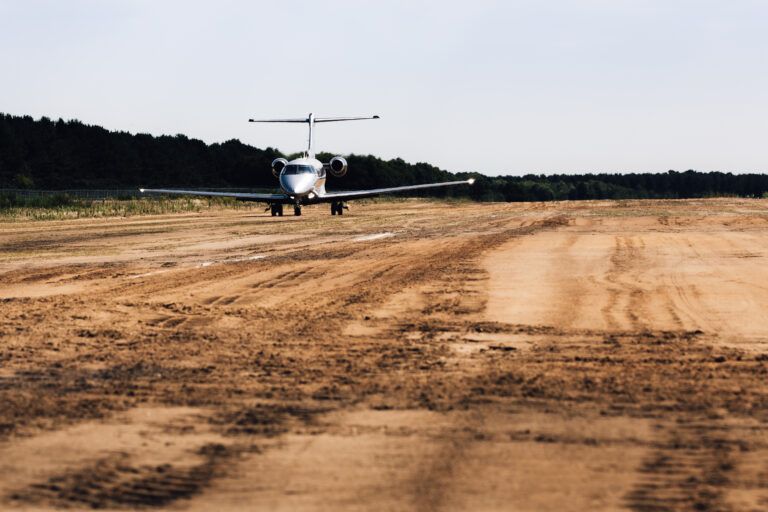Words by Paul E Eden
Even considering the capabilities of its legendary PC-6 and PC-12, Pilatus’ ambitions for the unpaved runway performance of its PC-24 jet bordered on the audacious. The Swiss OEM’s first twin-engined aircraft and its first jet, the PC-24 is equally at home flying into Farnborough as a VIP private jet as it is onto an outback strip on a Royal Flying Doctor Service aeromedical mission in Australia.
Formerly chief test pilot at the UK CAA, Paul Mulcahy took the senior test pilot role at Pilatus during the PC-24 program. Intimately involved in designing, flying and documenting the type’s trials campaign, he says that the unpaved runway capability was originally intended as part of the type’s initial type certification, awarded in 2017. In the event, certification to operate from dry sand and gravel was awarded late in 2018, with full unpaved capability certified early in 2020.
Unpaved operations
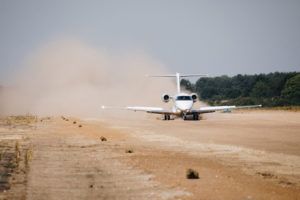
Pilatus rolled out the first prototype PC-24 in 2014, Mulcahy and Reto Aeschlimann taking it up for its maiden flight on May 11, 2015. “The expectation was that by summer 2017 we would have done all the certification items, including unpaved operations. But it soon became clear there was too much to do. As we slipped behind the curve, it was best to move items not essential to initial type certification, including unpaved operations,” Mulcahy says.
The process of planning for an unpaved campaign therefore began in parallel with the final type certification effort. At the end of 2017, Pilatus laid a chalk bed on the disused runway at its Buochs test airfield in Switzerland and conducted runway trials. “We chose chalk because we would clearly see its impact on the underside of the aircraft, tyres, structure and engines,” Mulcahy recalls.
The resulting data convinced the team that it was safe to expand the unpaved surface envelope into roughly two years of off-and-on trials on five surfaces and three substrates. Mulcahy says, “I remember a big discussion about Fano, Italy. It looks like grass but is actually described as sparse vegetation, which was on our list. We also wanted to do sand and gravel, and Arctic snow-type compacted gravel, so we built a plan and started on a grass runway at Sion.
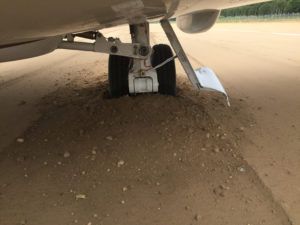
“We wanted to see how the structure bore the impact loads of a rough surface. The runway at Sion was only 600m [2000ft], so we were never going to take-off and land, but we could measure stroke loads on the shock struts.
“We measured them throughout the campaign so we’d know what those numbers were for fatigue purposes and to make sure they didn’t exceed any maximum or minimum values.
“Once we had expectation of gravel dispersion from the chalk bed and fatigue data from Sion, we went to Fano. The sparse vegetation there was easy, but then it was off to RAF Woodbridge in Suffolk, England, for many months of trials.
“From then on, the tests we flew elsewhere were really all variations of the same thing.”
A PC-24 order from the Royal Flying Doctor Service (RFDS) of Australia was particularly significant to Pilatus, because the RFDS wanted unpaved capability as a standard operating requirement. The quest to find a surface in Europe close to what the PC-24 would encounter in Australia soon focussed on Spain, but Woodbridge ultimately offered a very close match and a 1,700m airfield – it had also previously hosted A400M natural surface trials.
Support infrastructure
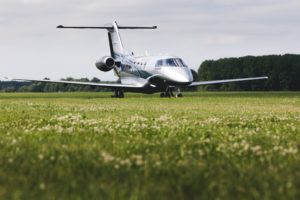 Conditions at Woodbridge were austere. Trials were flown with two pilots and a flight test engineer (FTE), sometimes two, while the support team and infrastructure was more substantial. “An admin team went out a few weeks before we did, along with the ground team, a French expert in earthworks and his three colleagues, who had previously been involved in the A400M work. He sourced agricultural equipment, including tractors and a compactor as well as farmers to prepare the surface.
Conditions at Woodbridge were austere. Trials were flown with two pilots and a flight test engineer (FTE), sometimes two, while the support team and infrastructure was more substantial. “An admin team went out a few weeks before we did, along with the ground team, a French expert in earthworks and his three colleagues, who had previously been involved in the A400M work. He sourced agricultural equipment, including tractors and a compactor as well as farmers to prepare the surface.
“Once we began flying, we would swap the engineers out and sometimes had a third pilot too, so that we could continue operations intensively without fatiguing ourselves. Also on the ground we had gear, tyre and brakes specialists for the undercarriage, and people measuring the aircraft’s performance. We didn’t have telemetry running, but they were talking to headquarters in Stans [Switzerland] in real time.
“We also hired facilities including fire vehicles and crews: three Portakabins for storage, briefings and domestic use, a water supply and electricity generation. The minimum team at any time numbered around 12, plus the lunch lady, who came in a van every day with hot food.”
The FTEs worked in the aircraft’s cabin, using toughened laptops slotted into dedicated stations. From those, they interacted with the data acquisition system (flight test information system) (DAS (FTI)). Mulcahy describes the FTI: “It collected data on around 6,000 aircraft parameters and plugs into the DAS. The two computer systems talk to each other, with the FTE overseeing the process and seeing some of the data in real time, depending on the script written for the test.”
The first and second PC-24 prototypes were both equipped with the FTI, comprising 1 tonne of equipment, housed within an enclosure and running down the right-hand side of the cabin, with the FTE installations to the left.
Mulcahy describes the test process: “To some extent it was driven by the weather, particularly the wind. We did a lot of performance and handling testing, so any take-off, landing or accelerate/stop required no more than 5kts of wind. There were also temperature imitations and for the dry testing we couldn’t work if there was any ‘wet’ whatsoever. It drove us to start early in the morning and sometimes we weren’t able to fly in the peak of the day if the wind got up.”
The ground team was vital to the trials. Equipped with radios, they usually took to the runway as soon as the aircraft had cleared and were often still on it when the jet was ready to line up for its next run. Comms were therefore essential, not only for safety but also so that the flight crew knew what damage had been caused on the previous run.
Runway hardness
 Before the PC-24 arrived, runway hardness had been assessed every 100m using a dynamic cone penetrometer unit (DCPU). The device measures penetration in centimetres, which is converted into a California Bearing Ratio (CBR). The CBR was essential for understanding the data and for creating what Mulcahy calls a “heat map” of the soft and hard points on the runway. Concrete has a CBR of 100, while harder gravel and dirt runways tend to be around 30. Strips either side of the runway were ploughed and compacted to create lower surfaces with a CBR as low as 7.
Before the PC-24 arrived, runway hardness had been assessed every 100m using a dynamic cone penetrometer unit (DCPU). The device measures penetration in centimetres, which is converted into a California Bearing Ratio (CBR). The CBR was essential for understanding the data and for creating what Mulcahy calls a “heat map” of the soft and hard points on the runway. Concrete has a CBR of 100, while harder gravel and dirt runways tend to be around 30. Strips either side of the runway were ploughed and compacted to create lower surfaces with a CBR as low as 7.
“We finished at Woodbridge late in summer 2018, then took a break for analysis. We’d done sparse vegetation with CBRs in the 20s and 30s, then Woodbridge for a different, softer substrate. We needed to do Arctic snow-type compacted gravel late that autumn or early winter, so we engaged with Transport Canada and visited three operational airfields.”
The priority had been to certify against the surfaces important to the RFDS. Once these were completed, attention turned to grass during 2019. “Some of my most unrewarding ends to flights have resulted from landing small aeroplanes on wet grass,” Mulcahy quips. “That’s why there’s a 50% safety factor for landing on wet grass, although my personal factor is 100%. I look for double the runway length that’s actually needed. Wet grass can be dangerous, so I was initially reluctant to land the PC-24 there.
“All the Pilatus pilots said the same, so we went back to the grass runway at Sion in summer 2019, then used a fire truck to apply an exact amount of water. With the aeroplane light we gently at low speed began trying stops on the wet runway. The results were surprisingly good.
“Inflated to just 76psi, the four main gear tyres, on the braking wheels, each have a relatively large friction surface in contact with the ground. There are also very good ground spoilers to kill lift and fabulous brakes, so the aircraft only takes about 30% more distance to stop on wet grass compared to dry.”
Having proven the PC-24 on Sion’s grass, the team went to Kunovice in the Czech Republic. “It has a hard runway and two long grass runways either side,” Mulcahy says. “We waited for rain to be inbound then headed off to the hard runway. Once it was really wet, we repeated the Woodbridge process on the grass runways. We measured the CBR each day and eventually reached a corner point at CBR 2, in pouring rain. Leaving ruts about 150mm [6in] deep on take-off and using full backstick, we realized that going further we would be entering a danger zone. We landed safely and called a stop there.”
Today, Mulcahy describes the PC-24’s anti-skid braking system as “spectacularly good”, arrived at through a process of careful tuning. “It took about a year to get there initially. We sometimes used to go for a dance when we put the brakes on, but the software was tuned and glitches ironed out, and eventually it went almost overnight from a dance routine to straight down the runway.”
Day-to-day
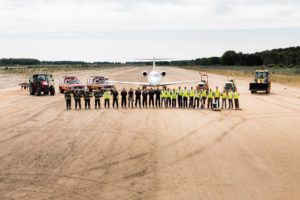 The translation of test data into safe day-to-day operations was carefully considered. A simple set of operating parameters was described from the extensive unpaved data set, as Mulcahy explains. “We wanted to offer the aeroplane down to CBR 7, which meant we needed to go lower than that to provide a safety margin. Our target was to go to 5 or possibly below and, at the end of the campaign, we revisited Woodbridge and again went as low as CBR 2 / 3.
The translation of test data into safe day-to-day operations was carefully considered. A simple set of operating parameters was described from the extensive unpaved data set, as Mulcahy explains. “We wanted to offer the aeroplane down to CBR 7, which meant we needed to go lower than that to provide a safety margin. Our target was to go to 5 or possibly below and, at the end of the campaign, we revisited Woodbridge and again went as low as CBR 2 / 3.
“At each test we’d gather data that was analytically correct so that we could release performance data for different substrates and surfaces, as a chart that allows correction compared to the data for a hard surface.” Throughout the trials process, the pilots also made notes ready for later incorporation into the aircraft flight manual.
Training for in-service pilots was informed through the operational suitability data (OSD) gathered as part of the certification process. Based on that information, the regulator’s OSD team revisited some of the unpaved sites with the Pilatus pilots for assessment exercises while simultaneously evaluating the performance data and training materials.
At each point in the unpaved test campaign, gathered data from undercarriage assessment, through CBR to rut depth, was analyzed before continuing to the next test point.
“There was never a cavalier attitude,” Mulcahy reports. “We considered a lot of information before progressing to the next point, which meant the program took a long time. Today though, considering the surfaces most users will fly onto, there is really no difference between how the aeroplane handles and brakes on a hard surface compared to an unpaved one,” he concludes.


